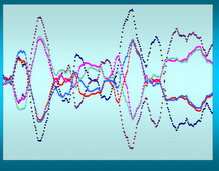The following chart is the first half-hour of GM on Friday using the 4-minute Java chart that I put up on my screens. You can see that the first three bars clearly show a reversal. Most often three bars are sufficient for this purpose.

I then switch to the 15-minute view that I prefer.

The bar marked “a” shows the 15-minute version of the first three 4-minute bars I show in the other chart. This clearly shows that a reversal has taken place. There was a tremendous sell-off to begin the day (which reflected the fact that the Dow INDU opened down) but this was just as quickly reversed.
Once I see a reversal occurring I wait for a confirmation of direction on the 15-minute charts. In this example one of my favorite set-ups occurred – a tag of the EMA 8 (two or three red bars slide sideways-down to the EMA 8). That is a mandatory buy in my book. An hour later we get the dreaded red candle top and another reversal - this time down. The trade is ended with the lower low at 11:30.
Later, around 12:30 or so, there was yet another reversal on the 4-minute chart. This is marked “b” on the chart above and below.

As a result of that reversal I switch back to the 15-minute charts and enter the trade on the first higher low and higher high beyond the 4-minute reversal (about 12:45). This trade we hold to the end of the day. Why wouldn’t I sell on the white bar with the lower low 3rd from the end? Because that bar is a white bar and just another tag of the ‘8. Had the next bar turned red (close below open) and been a lower low I would sell then – it was a red bar but not a lower low so we could continue the trade. More often than not you will get a flattening at the end of the run. I usually wait for the trade to turn down (lower low red bar) before I end it. I’ve learned that if I wait and the trade goes higher it will often go up significantly.
Note that I only use the close to determine whether the bar is red or white. The most important information - at least in my estimation - are the high and the low of the period. They show the dynamics of the buying and selling. The close is more of an accident of time than a deliberate position. By this I mean that the close might have been higher or lower had the period under observation not timed out.
Also the volume at points “a” and “b” are very similar in nature. While not the same magnitude the concept is the same – a blow-off bottom is a blow-off bottom. But always wait for confirmation.
The higher lows/higher highs reversal method works on every time frame from seconds to months. But none of this information is meant to induce anyone to risk any money in the stock market. I believe that if you are not ready to spend a number of months (if not years) studying (not paper trading but studying) charts and printing charts and looking at charts and marking on charts you might as well go and put your money on the line in Vegas. While I sometimes make it look easy - you must have great patience and wait for a proper set-up before you get invested. There are a number of reasons why new traders go broke - one is inadequate capitalization, a second is not having adequate preparation or knowledge, but the most important one is playing a trade based on hope.
Charts as always copyright prophet.net - an excellent company.

3 comments:
Very educational post, Marlyn.
Are you saying that the confirmation you're looking for comes on the longer chart (15 minute in this case)? Is the switching of time periods just your personal preference or do you find that a confirmation using the 4 minute chart isn't reliable enough?
I could trade off the 4-minute charts complete with confirmation but I prefer 15's. The reason for that is the shorter the time frame and the shorter the run (most of the time). I prefer the longer run so I like to use the 15 minute charts.
Who knows where the high might be.
Post a Comment